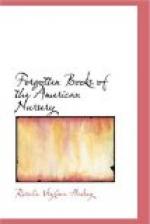The question at once arises as to the reason why this literature came into existence; why was it that children after seventeen hundred and fifty should have been favored in a way unknown to their parents?
To even the casual reader of English literature the answer is plain, if this subject of toy-books be regarded as of near kin to the larger body of writing. It has been somewhat the custom to consider children’s literature as a thing wholly apart from that of adults, probably because the majority of the authors of these little tales have so generally lacked the qualities indispensable for any true literary work. In reality the connection between the two is somewhat like that of parent and child; the smaller body, though lacking in power, has closely imitated the larger mass of writing in form and kind, and has reflected, sometimes clearly, sometimes dimly, the good or bad fashions that have shared the successive periods of literary history, like a child who unconsciously reproduces a parent’s foibles or excellences.
It is to England, then, that we must look to find the conditions out of which grew the necessity for this modern invention—the story-book.
The love of stories has been the splendid birthright of every child in all ages and in all lands. “Stories,” wrote Thackeray,—“stories exist everywhere; there is no calculating the distance through which the stories have come to us, the number of languages through which they have been filtered, or the centuries during which they have been told. Many of them have been narrated almost in their present shape for thousands of years to the little copper-coloured Sanscrit children, listening to their mothers under the palm-trees by the banks of the yellow Jumna—their Brahmin mother, who softly narrated them through the ring in her nose. The very same tale has been heard by the Northern Vikings as they lay on their shields on deck; and the Arabs couched under the stars on the Syrian plains when their flocks were gathered in, and their mares were picketed by the tents.” This picturesque description leads exactly to the point to be emphasized: that children shared in the simple tales of their people as long as those tales retained their freshness and simplicity; but when, as in England in the eighteenth century, the literature lost these qualities and became artificial, critical, and even skeptical, it lost its charm for the little ones and they no longer cared to listen to it.
Fashion and taste were then alike absorbed in the works of Dryden, Pope, Addison, Steele, and Swift, and the novels from the pens of Richardson, Fielding, and Smollett had begun to claim and to hold the attention of the English reading public. The children, however, could neither comprehend nor enjoy the witty criticism and subtle treatment of the topics discussed by the older men, although, as will be seen in another chapter, the novels became, in both the original and in the abridged forms, the delight of many a “young master and miss.” Meanwhile, in the American colonies the people who could afford to buy books inherited their taste for literature as well as for tea from the Puritans and fashionables in the mother country; although it is a fact familiar to all, that the works of the comparatively few native authors lagged, in spirit and in style, far behind the writings of Englishmen of the time.




